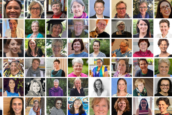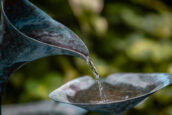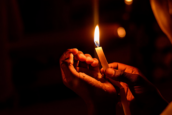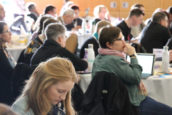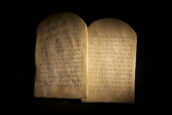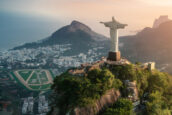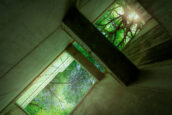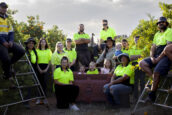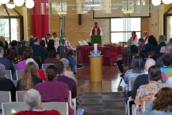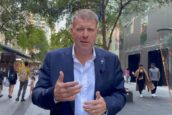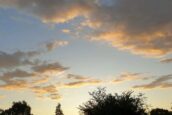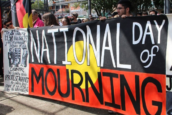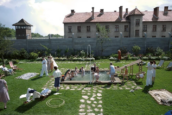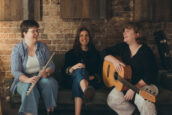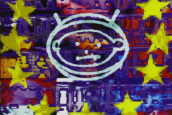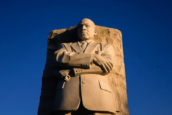
What is God doing with the Darling River?
For nine days in August, a group of 35 from NSW, ACT and Victoria set out on a journey along the Darling River. The group departed from Dubbo and followed the course of the Darling, as it weaves its way through rural Australian to the junction with the Murray River at Wentworth, before returning to Dubbo via Broken Hill and Cobar.
Their goal: to experience the river and outback; learn about life in the Basin, and; meet with churches and communities along the way. Together they grappled with perspectives on water use, land use and other complex issues, and reflected and shared about who we are in Creation and what God is doing in western NSW.
Diversity and competing needs
The Darling River tour was bigger than last year’s Murray River tour – with two buses, two trailers and two 4x4s. Our participants came from many places and not all were church attenders. There were farmers, eco-ministers, First Nation leaders, and Moderators past and present.
Hearing the commentary on the road was informative for me because as Rural Chaplain, I drive these roads. I now know better what is happening ecologically – dry creek beds are okay; they are there for when it rains to move water across the landscape. In 2012, the Menindee lakes were full and the banks covered with recreational vehicles. Today, bird numbers are down and just a trickle runs through the gates of the lake.
This is hard on those in tourism, but this is how it is. The lakes, like the creeks, fill only when it floods. The problem is that Broken Hill needs water from the lake for its town water supply. But others want a lake system for boating and fishing or just that great feeling of sitting next to water. These are the issues the Synod’s MDB group is listening to: God’s creation, and people’s needs for farming, living and playing.
These claims are all important, but who will share? Can we all have our needs met always?
Phill Matthews, Narrabri
Measuring out time in this ancient land
We gathered high on the ‘Walls of China’, the enormous sand dune on the shores of Lake Mungo’s ancient dry lake bed, home to Mungo Lady, who walked this land more than 40,000 years ago. Paakantyi elder Graham Clarke crouched on his haunches, smoothed some sand and began to draw a circle that spiralled out into ever larger and larger circles.
Graham looked up into our faces and suggested as, one by one, the circles spiralled out beneath his fingertip, we later-comers have divided time into circles of hours and days, seasons and years, even life-spans; but for Indigenous people, time is measured in millennia.
Looking up from Graham’s drawing in the sand, we slowly rotated our bodies taking in the uninterrupted 360-degree horizon stretching off in all directions across the plain of this vast and ancient land. One could not fail to be moved by the eternal mystery that surrounds us all.
Despite the seeming insignificance of one’s own existence against the endless sweep of the horizon, or knowledge of the eons of time past since Mungo Lady walked this land, we also became aware that we were part of a bigger picture including, but also beyond, ourselves. We were in relationship with a deeper reality that gave meaning to our existence and clothed all humankind with dignity.
As we walked down from the Walls of China to the dry lake bed below, we began to feel the deep sense of connectedness the First Peoples have with the earth, and the responsibility we all share in caring for the well-being of all creation entrusted to us in our shared humanity.
Margaret and Ivan Roberts, Sydney
Isolation, resilience and hospitality
Not long into the tour we got a feeling of the vast distances which the people iving out there have to cope with. It’s a long way between towns.
Mostly these were communities of a few houses and a hotel which was also the general store. Not the general conveniences which some people on the tour were used to!
There were long, dusty, corrugated roads to travel. When it rains these are impassable, adding to the isolation.
The Darling River is a vital part of these communities. The isolation of the people who live in this part of the country was very apparent; however the people seemed to take this in their stride. On a station south of Menindee, we heard about the difficulties obtaining permission to move the pump in the drought. The usual waterhole had dried up, costing time and money to access stock and domestic water. Here, they rely on a generator for electricity.
Very special people live in this country. Despite the tyranny of distance and isolation, they love where they live, and they are happy to share their stories. The hospitality and resilience of these wonderful people can only be admired.
Myra Cowell, Finley
The sustainability challenge
The pilgrimage down the Darling reinforced for me the difficult dilemmas that face us as Australians seeking to live sustainably on this continent.
The Darling Basin is huge and very flat, with only about 100 metres of fall over the 1,600 kilometres from Bourke to the Great Southern Ocean. Most of the landscapes we saw were floodplains of ancient rivers, which had carved many prior stream channels that served wetter and dryer climates of long ago.
Past flood levels at the tops of tall red river gums and old buildings tell of a hugely variable climate. This is how the Darling works — large floods fill these landscapes only to slowly empty as water flows back to the main channels and down to the river, or remains behind to be evaporated. The river’s health and its ecology thrive on this sequence of floods and droughts.
It is very hard for us to build stable communities in these environments. Regulating flows cannot be done easily on the Darling, and the use of naturally ephemeral lakes like those around Menindee has lots of problems. Unfortunately, decades of research into hydrology, ecology and geomorphology tell us that engineering interventions like these will not always help and can even make the problems far worse.
Science is telling us a hard message: we have run out of easy solutions and need to make difficult adjustments. I can see great resilience in communities and opportunities for our faith communities to work with and support our people in building knowledge and human capital, to plan and find new solutions to living and prospering in the boom and bust of the Darling Basin.
John Williams, Canberra
Who speaks for the river?
Ten years ago I criss-crossed the Basin for several months, asking groups of people from Uniting Church congregations about how they related their Christian faith to the environment in which they lived. The wonderful tour our diverse group has just enjoyed has taught me that attitudes are, as they were then, basically anthropocentric.
While it was important and valuable to hear these stories of people living in the Darling Basin, and while each of them has its own validity and value as our society wrestles with how to do justice to jostling interests, I found myself thinking, ‘Thank God that we’re learning to talk with each other, at least in the Uniting Church.’
But in this discussion, who speaks for the interests of the Basin’s biota? Who speaks for the river?
David Reichardt, Sydney
Learn more about the tour
The Darling River Tour was organised by the Synod’s Murray Darling Basin (MDB) Group. The group is taking forward the Synod’s vision for our Church to be a transforming presence for the common good in the Murray Darling Basin. Click here for information about the group and future MDB tours.
- Categories: Features
- Tags: climate change, environment








